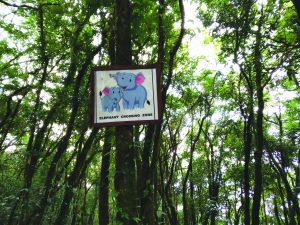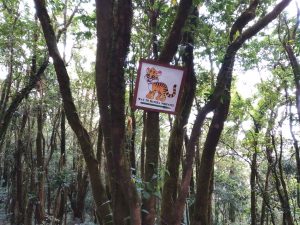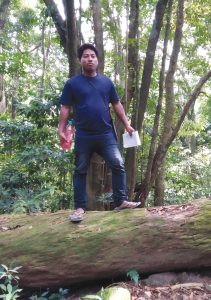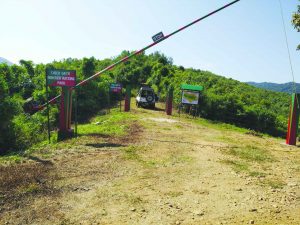The road to the Nokrek Biosphere Reserve and National Park from Sasatgre village is an impossible ride. One can feel the drumming of bones even inside a tough Gypsy jeep. But that is a small price to pay for a trip to the wild in the Nokrek Range, about 45 km from Tura town in West Garo Hills.
The national park is home to numerous species of flora and fauna. The definite stop for any visitor to the Nokrek is Daribokgre where Govin Ch Marak and his wife Mojina T Sangma run Balkasin Guest House, which is set amid nature and offers a picturesque view of the green hills.


Marak was a jhum cultivator but he quit three years ago to start the guest house. Now, it is the source of income not only for the owners but also for villagers who sell their produce to visitors. Some also work for Marak. “I get more foreign tourists. Recently, a family came from France. Locals too visit the place,” says Marak as he relaxes on a log under an orange tree.
The trek to the forest from Daribokgre is over two hours. The check gate at the entrance of the main reserve area says Nokrek National Park. Vehicles are allowed to go till this point.
The Nokrek is the highest peak in Garo Hills and home to different species of wild animals, like elephants and endangered Hoolock Gibbons, and birds. Rare varieties of indigenous orchids are also found in the forest. But what makes it unique is the species of Citrus indica that is endemic to the place. Locally, this variety of oranges is called memang narang.
The villagers believe that their first forefathers, abong noga and silme doka, used the citrus for curing diseases of their domestic animals.
Besides its rich biodiversity, many myths are related to the Nokrek reserve. The presence of mande burung, or ape man, is one.
Elwel Ch Momin, the 25-year-old guide at the Nokrek, rejects that stories about the ape man are only myths. “Many people have seen foot marks. Though I have not seen but I believe he exists and protects the forest,” says Elwel, who has been exploring the Nokrek since childhood.

It is a surreal experience to walk through the forest. The green canopy gets denser as one goes deeper into the jungle. There are signboards telling visitors not to desecrate the forest and also about the paths taken by elephants. One signboard says, “Nature is not a place to visit, it is home.”
Darmen G Momin, a resident of Sasatgre, says the trees which have mossy barks are among the oldest and belonged to abong noga and silme doka. Is it another myth? “No,” Momin says emphatically. “It is a strong belief. See this space where the density of trees is less. This was the place where our forefathers lived,” he explains as he points to an area inside the forest where most of the trees are “ancient”.
Problems aplenty
While the local population wants to leverage the tourism potential of the place, dilapidated roads are a major hindrance. Marak says the villagers have approached the authorities but nothing has been done so far.
Local MLA Marcuise N Marak says since the area is restricted and a protected forest, it is difficult to get sanction for a road project. “I had proposed PMGSY (Pradhan Mantri Gram Sadak Yojana) but the Ministry of Forest and Environment did not give clearance. I recently spoke to the chief minister about the problem and he is keen (to develop the road). We can have an all-weather road made of stones and pebbles,” he says and adds that the process has already begun.
Modernity has crept into the remote area in various forms. One can see electric poles standing incongruously among trees on the way to Daribokgre. The mesh of wires is an eye sore. Momin says the electric wires are posing danger to birds and arboreal animals.

“The village (Daribokgre) is near the Nokrek forest and this makes the wildlife vulnerable. There are so many electric poles and the wires are criss-crossing precariously. Birds are often killed,” he adds.
According to Momin, solar light can be the solution “but it has never been considered”.
But the MLA says the project is in the pipeline. “Madam Agatha (Tura MP Agatha Sangma) had already proposed it to the Government of India… Things are taking so long because of some procedures,” he informs.
The change in lifestyle of locals and concrete structures are also adding to the problems, says Momin. The corrugated iron sheets have replaced traditional thatched roofs and birds which would nest in the grass are being forced to find space in trees.
“Our lifestyle is affecting the flora and fauna of the area and this is wrong. The Nokrek is a biodiverse area and there should be awareness among people on preservation and protection of this place,” he asserts.
Momin also points out that many locals are planting arecanut, “which is not indigenous to the place”.
“In fact, no sapling from outside should be planted. There should be proper awareness on how to protect the forest, the indigenous trees and the wildlife. The Nokrek is a sacred place and all of us have to contribute to the preservation process,” he concludes.
~ NM



